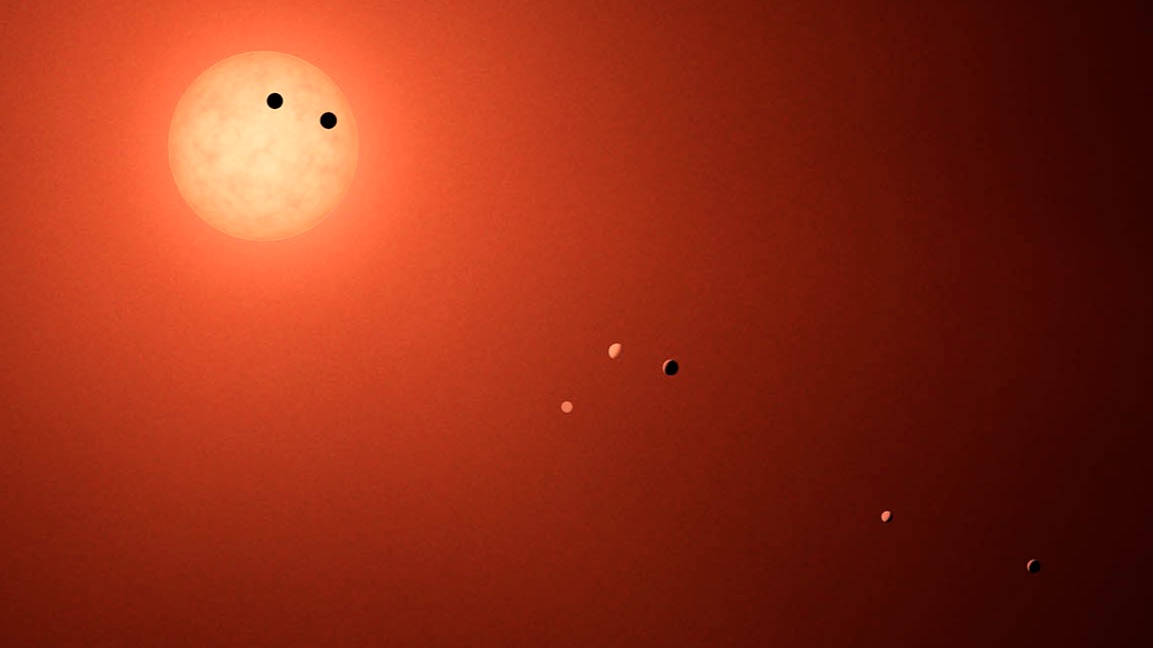Kepler Telescope Beams Back Raw Data on Earth-Size Exoplanets of TRAPPIST-1

Scientists, have at it: NASA has released raw data from the Kepler Space Telescope probing the many Earth-size planets around the star TRAPPIST-1.
In February, data from the Spitzer Space Telescope revealed that seven planets orbit the ultracool dwarf star, and now, the recently released Kepler data (and its final, processed version) will give a complementary look at the worlds, three of which might orbit in the star's habitable zone.
Kepler's observations could provide more detail about the gravitational interactions among the planets, and perhaps reveal even more planets around the star, NASA officials said in a statement. [Meet the Planets of TRAPPIST-1 (Slideshow)]
As part of its K2 mission, Kepler examined the TRAPPIST-1 system from Dec. 15, 2016, to March 4, 2017 — and its data became much more exciting upon the Feb. 22 announcement of additional Earth-size planets orbiting the star. Yesterday (March 8), Kepler researchers released the unprocessed data from that survey for astronomers to use in preparing research proposals.
"Scientists and enthusiasts around the world are invested in learning everything they can about these Earth-size worlds," Geert Barentsen, K2 research scientist at NASA's Ames Research Center in California, said in the NASA statement. "Providing the K2 raw data as quickly as possible was a priority to give investigators an early look so they could best define their follow-up research plans. We're thrilled that this will also allow the public to witness the process of discovery."
The release is timely because many proposals to study TRAPPIST-1 this winter with ground-based telescopes are due this month, the statement said.
On the Kepler website, Barentsen encouraged scientists to dig into the results and blog or tweet analysis, but advised everyone to wait until the final, processed results are released in late May to cite them in journal papers.
Breaking space news, the latest updates on rocket launches, skywatching events and more!
Barentsen also included a preliminary graph of the light curve, the way the star darkened as planets passed across it, which shows hints of at least six planets (as well as star spots) visible in the data.
When K2's December-March observation plan was established, TRAPPIST-1's planets were unknown, and the star system wasn't on the list for investigation. But researchers found evidence of three planets around the star in May 2016, so the Kepler team adjusted the mission to include the newly exciting target.
"We were lucky that the K2 mission was able to observe TRAPPIST-1," Michael Haas, science office director for the Kepler and K2 missions at Ames, said in the statement. "The observing field for Campaign 12 [the December-March campaign] was set when the discovery of the first planets orbiting TRAPPIST-1 was announced, and the science community had already submitted proposals for specific targets of interest in that field.
"The unexpected opportunity to further study the TRAPPIST-1 system was quickly recognized, and the agility of the K2 team and science community prevailed once again," Haas added.
Kepler's original and K2 missions have been responsible for more than 2,400 confirmed exoplanet discoveries. The space telescope uses extremely precise measurements of stars' brightness over time to identify little dips in brightness that indicate planets in front of the star, called the transit method of exoplanet detection.
Although the transit method can identify only planets that are oriented to pass by the star from Earth's point of view, it's an extremely powerful technique. The Spitzer Space Telescope, which counted the seven planets around TRAPPIST-1, used a similar process measuring infrared light.
NASA's upcoming James Webb Space Telescope, another infrared telescope, could give researchers an even more detailed view of the planets, and help scientists measure whether those potentially habitable ones have atmospheres friendly to life. The telescope will be powerful enough to analyze the light passing from the star through the planets' atmospheres, letting researchers determine their composition.
Email Sarah Lewin at slewin@space.com or follow her @SarahExplains. Follow us @Spacedotcom, Facebook and Google+. Original article on Space.com.

Sarah Lewin started writing for Space.com in June of 2015 as a Staff Writer and became Associate Editor in 2019 . Her work has been featured by Scientific American, IEEE Spectrum, Quanta Magazine, Wired, The Scientist, Science Friday and WGBH's Inside NOVA. Sarah has an MA from NYU's Science, Health and Environmental Reporting Program and an AB in mathematics from Brown University. When not writing, reading or thinking about space, Sarah enjoys musical theatre and mathematical papercraft. She is currently Assistant News Editor at Scientific American. You can follow her on Twitter @SarahExplains.
